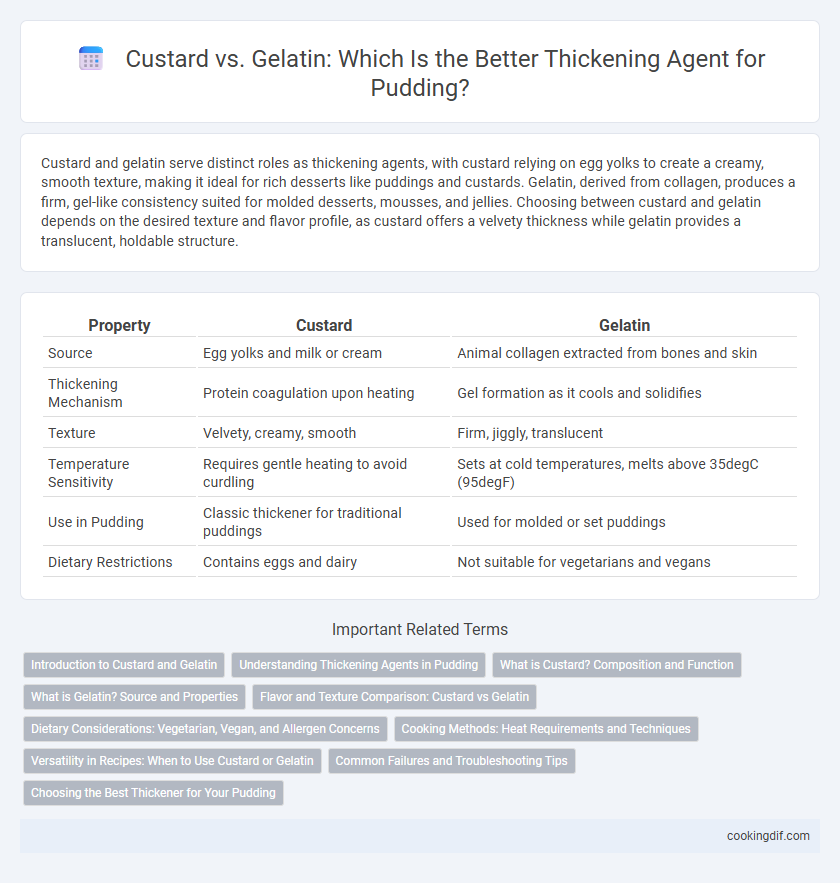Custard and gelatin serve distinct roles as thickening agents, with custard relying on egg yolks to create a creamy, smooth texture, making it ideal for rich desserts like puddings and custards. Gelatin, derived from collagen, produces a firm, gel-like consistency suited for molded desserts, mousses, and jellies. Choosing between custard and gelatin depends on the desired texture and flavor profile, as custard offers a velvety thickness while gelatin provides a translucent, holdable structure.
Table of Comparison
| Property | Custard | Gelatin |
|---|---|---|
| Source | Egg yolks and milk or cream | Animal collagen extracted from bones and skin |
| Thickening Mechanism | Protein coagulation upon heating | Gel formation as it cools and solidifies |
| Texture | Velvety, creamy, smooth | Firm, jiggly, translucent |
| Temperature Sensitivity | Requires gentle heating to avoid curdling | Sets at cold temperatures, melts above 35degC (95degF) |
| Use in Pudding | Classic thickener for traditional puddings | Used for molded or set puddings |
| Dietary Restrictions | Contains eggs and dairy | Not suitable for vegetarians and vegans |
Introduction to Custard and Gelatin
Custard is a creamy mixture primarily thickened with egg yolks, providing a rich texture and delicate flavor ideal for desserts. Gelatin, a protein derived from animal collagen, acts as a gelling agent that sets liquids into a firm, clear consistency frequently used in mousses and molded desserts. Both agents serve to thicken puddings but differ significantly in texture and preparation methods.
Understanding Thickening Agents in Pudding
Custard and gelatin serve as popular thickening agents in pudding, each offering distinct textures and properties. Custard, made from egg yolks and milk, provides a creamy, smooth consistency through protein coagulation when heated. Gelatin, derived from collagen, creates a firmer, gel-like structure by setting as it cools, making it ideal for more stable, sliceable puddings.
What is Custard? Composition and Function
Custard is a thickening agent made primarily from a mixture of milk or cream, egg yolks, and sugar, which coagulate upon gentle heating to create a smooth, creamy texture. The proteins in the egg yolks denature and bond during cooking, providing custard its rich consistency and ability to thicken desserts like puddings and tarts. Unlike gelatin, custard relies on protein coagulation rather than structural gel formation, offering a softer, more velvety mouthfeel in culinary applications.
What is Gelatin? Source and Properties
Gelatin is a natural protein derived from collagen in animal connective tissues, such as bones and skin, primarily sourced from pigs and cows. It functions as a gelling agent that melts in the mouth, producing a smooth and creamy texture ideal for puddings. Its unique properties include the ability to form thermoreversible gels, setting when cooled and melting again when warmed, differentiating it from custard thickened by eggs or starch.
Flavor and Texture Comparison: Custard vs Gelatin
Custard offers a rich, creamy texture with a natural, egg-based flavor that enhances the dessert's depth, while gelatin provides a smooth, jelly-like consistency with a more neutral taste, allowing added flavors to shine. Custard thickens through the coagulation of egg proteins, creating a dense and velvety mouthfeel, whereas gelatin sets by forming a flexible, bouncy gel that holds its shape firmly. The choice between custard and gelatin depends on whether a luscious, velvety texture or a light, firm gel is desired to complement the pudding's flavor profile.
Dietary Considerations: Vegetarian, Vegan, and Allergen Concerns
Custard thickened with eggs suits vegetarian diets but excludes vegans and those allergic to eggs or dairy. Gelatin, derived from animal collagen, is unsuitable for vegetarians and vegans, prompting the use of plant-based alternatives like agar-agar or pectin for thickening. Consumers with dietary restrictions should verify ingredient sources to ensure compatibility with vegetarian, vegan, or allergen-sensitive needs.
Cooking Methods: Heat Requirements and Techniques
Custard thickens through the coagulation of egg proteins when gently heated, requiring careful temperature control to avoid curdling, typically achieved via stovetop simmering or bain-marie methods. Gelatin sets by cooling after being dissolved in warm liquid, enabling it to thicken without ongoing heat, commonly used in chilled or no-bake puddings. Understanding heat sensitivity differences is crucial for choosing the appropriate thickening agent and method to achieve the desired texture and stability in pudding recipes.
Versatility in Recipes: When to Use Custard or Gelatin
Custard, made from eggs and milk, offers a creamy texture and is ideal for recipes requiring rich, smooth thickness such as classic puddings, custard tarts, and flans. Gelatin provides a clear, firm set without altering flavor, making it perfect for mousses, jellies, and layered desserts that benefit from a delicate, stable structure. Choosing between custard and gelatin depends on the desired consistency and temperature stability in recipes, with custard excelling in warm dishes and gelatin preferred for chilled preparations.
Common Failures and Troubleshooting Tips
Custard often curdles when heated too quickly or at excessive temperatures, leading to a grainy texture, while gelatin can fail to set if not fully dissolved in warm liquid or if exposed to too much acid or enzymatic fruit. To prevent custard curdling, cook it over low heat with constant stirring and remove from heat just before thickening; for gelatin, ensure complete dissolution by blooming in cold water before mixing and avoid adding acidic ingredients until after setting. Both thickening agents require precise temperature control and careful ingredient handling to achieve smooth, stable pudding consistency.
Choosing the Best Thickener for Your Pudding
Custard, made from egg yolks and milk, creates a rich, creamy texture that thickens pudding with a smooth, velvety consistency ideal for traditional desserts. Gelatin, derived from animal collagen, offers a firmer, more elastic set, making it perfect for chilled or molded puddings that require a stable structure. Choosing between custard and gelatin depends on the desired texture and temperature stability of the pudding, with custard providing warmth-friendly creaminess and gelatin delivering a cool, jiggly firmness.
Custard vs Gelatin for thickening agent Infographic

 cookingdif.com
cookingdif.com